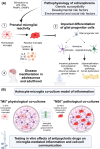Influence of antipsychotic drugs on microglia-mediated neuroinflammation in schizophrenia: perspectives in an astrocyte-microglia co-culture model
- PMID: 40171306
- PMCID: PMC11959008
- DOI: 10.3389/fpsyt.2025.1522128
Influence of antipsychotic drugs on microglia-mediated neuroinflammation in schizophrenia: perspectives in an astrocyte-microglia co-culture model
Abstract
Schizophrenia is a severe mental disorder with a strong lifetime impact on patients' health and wellbeing. Usually, symptomatic treatment includes typical or atypical antipsychotics. Study findings show an involvement of low-grade inflammation (blood, brain parenchyma, and cerebrospinal fluid) in schizophrenia. Moreover, experimental and neuropathological evidence suggests that reactive microglia, which are the main resident immune cells of the central nervous system (CNS), have a negative impact on the differentiation and function of oligodendrocytes, glial progenitor cells, and astrocytes, which results in the disruption of neuronal networks and dysregulated synaptic transmission, contributing to the pathophysiology of schizophrenia. Here, the role of microglial cells related to neuroinflammation in schizophrenia was discussed to be essential. This review aims to summarize the evidence for the influence of antipsychotics on microglial inflammatory mechanisms in schizophrenia. Furthermore, we propose an established astrocyte-microglia co-culture model for testing regulatory mechanisms and examining the effects of antipsychotics on glia-mediated neuroinflammation. This could lead to a better understanding of how typical and atypical antipsychotics can be used to address positive and negative symptoms in schizophrenia and comorbidities like inflammatory diseases or the status of low-grade inflammation.
Keywords: antipsychotic drugs; astrocyte-microglia co-culture model; glia; neuroinflammation; psychotic disorders; schizophrenia.
Copyright © 2025 Faustmann, Corvace, Faustmann and Ismail.
Conflict of interest statement
The authors declare that the research was conducted in the absence of any commercial or financial relationships that could be construed as a potential conflict of interest.
Figures

References
Publication types
LinkOut - more resources
Full Text Sources

